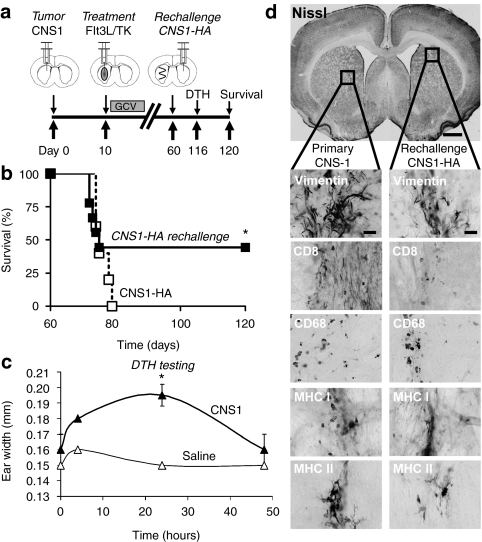Figure 4.
Rats bearing intracranial CNS1 brain tumors treated with Ad-Flt3L and Ad-TK survive rechallenge with CNS1-HA cells. (a) CNS1 cells were implanted into the striatum of Lewis rats. Ten days later, animals received an intratumoral injection of Ad-Flt3L + Ad-TK. Ganciclovir (GCV) was administered via intraperitoneal injection for 7 days. Sixty days later, animals surviving long-term were rechallenged with CNS1-HA cells in the contralateral hemisphere. No further treatment was administered. Naive animals were implanted with CNS1-HA cells to control for cell viability (n = 4–5). Animals were monitored for survival and underwent delayed type hypersensitivity (DTH) testing 4 days before euthanasia. (b) Kaplan–Meier curve depicting survival of tumor bearing rats rechallenged with CNS1-HA cells or naive rats implanted with CNS1-HA cell as a control. *P < 0.05, Mantel log-rank test. (c) DTH testing was performed in long-term survivors 4 days before euthanasia. Irradiated CNS1 cells were injected intradermally into the pinna of the right ear, and the left pinna received saline. The thickness of the pinna was recorded with slide calipers after 4, 24, and 48 h. *P < 0.05 versus saline ear (randomization test). (d) Neuropathological analysis of the brain at 60 days after rechallenge. CD8, CD8α+ cytotoxic T cells; CD68, macrophages/activated microglia; Flt3L, fms-like tyrosine kinase 3 ligand; MHC, major histocompatibility complex; TK, thymidine kinase; vimentin, tumor cells and reactive astrocytes.

